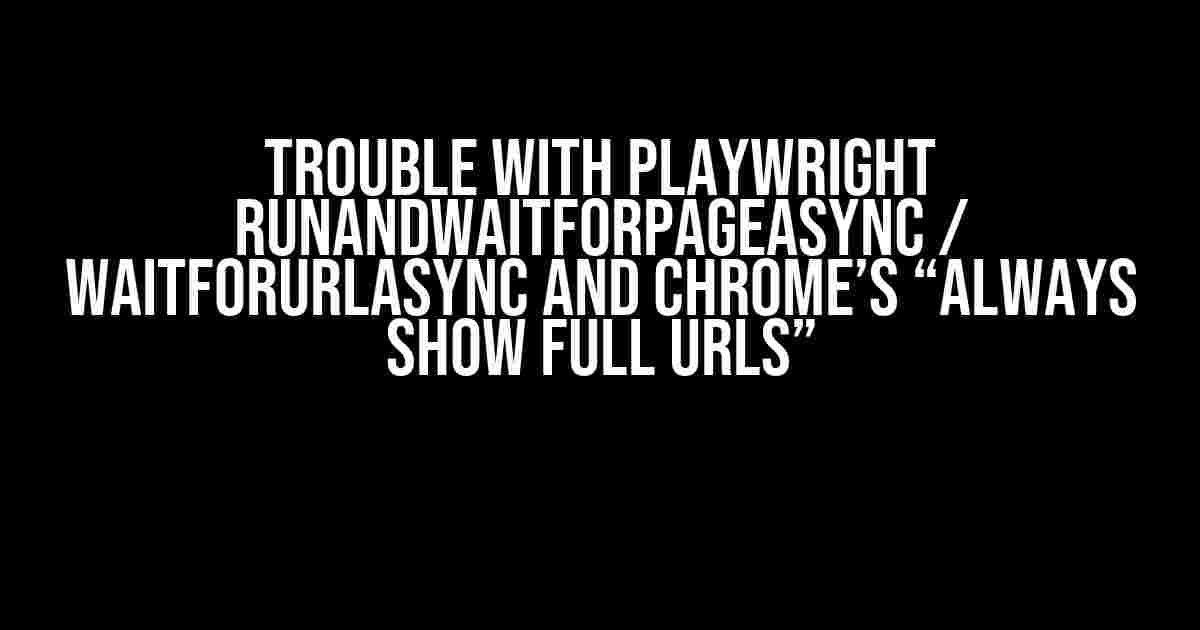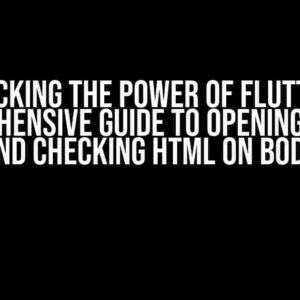Are you tired of wrestling with Playwright’s RunAndWaitForPageAsync and WaitForURLAsync methods, only to have them fail miserably due to Chrome’s pesky “Always show full URLs” feature? You’re not alone! In this comprehensive guide, we’ll dive into the world of Playwright and Chrome to help you overcome this frustrating issue once and for all.
What’s the Problem?
Before we dive into the solution, let’s understand the problem. When you use Playwright’s RunAndWaitForPageAsync or WaitForURLAsync methods, they rely on the browser’s URL changing to determine when a page has finished loading. However, when Chrome’s “Always show full URLs” feature is enabled, the URL in the address bar doesn’t change, causing these methods to fail.
Chrome’s “Always show full URLs” Feature
This feature, introduced in Chrome 86, aims to improve user experience by displaying the full URL in the address bar, even if the page has redirected or changed. While it’s a great feature for users, it can be a nightmare for automation testing.
Solutions
Luckily, there are a few ways to tackle this issue. We’ll explore each solution in detail, so you can choose the one that best fits your needs.
Solution 1: Disable “Always show full URLs” in Chrome
The simplest solution is to disable this feature altogether. You can do this by launching Chrome with the following command-line argument:
--disable-features=msafThis will disable the “Always show full URLs” feature, and Playwright’s RunAndWaitForPageAsync and WaitForURLAsync methods should work as expected.
Solution 2: Use WaitForLoadStateAsync
Instead of relying on the URL change, you can use Playwright’s WaitForLoadStateAsync method to wait for the page to finish loading. This method takes a load state as an argument, which can be “load”, “domcontentloaded”, or “networkidle”.
using var playwright = await Playwright.CreateAsync();
await using var browser = await playwright.Chromium.LaunchAsync();
await using var context = await browser.NewContextAsync();
await using var page = await context.NewPageAsync();
await page.GotoAsync("https://example.com");
await page.WaitForLoadStateAsync("networkidle");
In this example, we’re waiting for the page to reach the “networkidle” load state, which means the page has finished loading and there are no more network requests.
Solution 3: Monitor the Page’s Load Event
Another approach is to monitor the page’s load event and wait for it to finish loading. You can do this by adding a listener to the page’s “load” event and waiting for it to be triggered.
using var playwright = await Playwright.CreateAsync();
await using var browser = await playwright.Chromium.LaunchAsync();
await using var context = await browser.NewContextAsync();
await using var page = await context.NewPageAsync();
await page.GotoAsync("https://example.com");
TaskCompletionSource loadTask = new TaskCompletionSource();
page.once("load", () => loadTask.TrySetResult(true));
await loadTask.Task;
In this example, we’re creating a TaskCompletionSource to wait for the page’s “load” event to be triggered. Once the event is triggered, the task is completed, and we can proceed with our test.
Best Practices
When working with Playwright and Chrome, keep the following best practices in mind:
-
Use the right load state
Choose the correct load state for your use case. If you’re waiting for a page to finish loading, “networkidle” might be a good choice. If you’re waiting for a specific element to load, “domcontentloaded” might be more suitable.
-
Monitor page events
Add listeners to page events, such as “load” or “DOMContentLoaded”, to detect changes in the page’s state.
-
Avoid relying on URL changes
Instead of relying on URL changes, use other methods to detect page changes, such as monitoring the page’s title or waiting for specific elements to appear.
-
Test your tests
Test your tests thoroughly to ensure they’re working as expected. Use different scenarios and edge cases to verify their reliability.
Conclusion
Troubleshooting Playwright’s RunAndWaitForPageAsync and WaitForURLAsync methods with Chrome’s “Always show full URLs” feature can be challenging, but with the right solutions and best practices, you can overcome this issue. Remember to choose the solution that best fits your needs, monitor page events, and test your tests thoroughly.
By following this guide, you’ll be well on your way to creating reliable and efficient automation tests with Playwright and Chrome.
| Solution | Description |
|---|---|
| Disable “Always show full URLs” in Chrome | Disable the feature by launching Chrome with the –disable-features=msaf command-line argument. |
| Use WaitForLoadStateAsync | Wait for the page to reach a specific load state, such as “networkidle” or “domcontentloaded”. |
| Monitor the Page’s Load Event | Add a listener to the page’s “load” event and wait for it to be triggered. |
Now, go forth and conquer the world of automation testing with Playwright and Chrome!
Frequently Asked Question
Get the scoop on troubleshooting Playwright’s RunAndWaitForPageAsync and WaitForURLAsync with Chrome’s “Always show full URLs” feature!
Why does Playwright’s RunAndWaitForPageAsync and WaitForURLAsync not work with Chrome’s “Always show full URLs” feature?
This is because Chrome’s “Always show full URLs” feature changes the URL displayed in the address bar, which in turn affects how Playwright’s waiting mechanisms work. By default, Playwright waits for the exact URL to match, but with this feature enabled, the URL is modified, causing the wait to fail.
How can I disable Chrome’s “Always show full URLs” feature for my Playwright tests?
You can disable this feature by adding the `–disable-features=HideURLSchemeAndTrivialSubdomains` flag when launching Chrome with Playwright. This flag will ensure that the URLs are displayed in their original form, allowing Playwright’s waiting mechanisms to work as expected.
What if I still want to use Chrome’s “Always show full URLs” feature, but also need Playwright’s waiting mechanisms to work?
In this case, you can modify your Playwright code to wait for the URL using a regex pattern instead of an exact match. This way, you can still use Chrome’s “Always show full URLs” feature while allowing Playwright to wait for the URL correctly.
Are there any other Chrome features that might affect Playwright’s waiting mechanisms?
Yes, other Chrome features like “Omnibox suggestion” or “URL rewriting” might also affect Playwright’s waiting mechanisms. It’s essential to be aware of these features and how they might impact your tests. You can experiment with different Chrome flags or modify your Playwright code to adapt to these features.
Where can I find more information about Chrome flags and their impact on Playwright?
You can find a list of available Chrome flags in the Chrome documentation. Additionally, the Playwright documentation and community forums are excellent resources for learning more about how different Chrome features and flags affect Playwright’s behavior.





